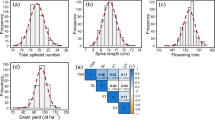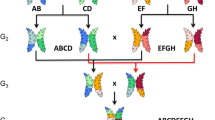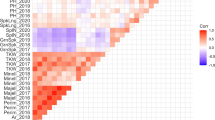Abstract
Earliness is very important for the adaptation of wheat to environmental conditions and the achievement of high grain yield. A detailed knowledge of key genetic components of the life cycle would enable an easier control by the breeders. The objective of the study was to investigate the effect of candidate genes on flowering time. Using a collection of hexaploid wheat composed of 235 lines from diverse geographical origins, we conducted an association study for six candidate genes for flowering time and its components (vernalization sensitivity and earliness per se). The effect on the variation of earliness components of polymorphisms within the copies of each gene was tested in ANOVA models accounting for the underlying genetic structure. The collection was structured in five groups that minimized the residual covariance. Vernalization requirement and lateness tend to increase according to the mean latitude of each group. Heading date for an autumnal sowing was mainly determined by the earliness per se. Except for the Constans (CO) gene orthologous of the barley HvCO3, all gene polymorphisms had a significant impact on earliness components. The three traits used to quantify vernalization requirement were primarily associated with polymorphisms at Vrn-1 and then at Vrn-3 and Luminidependens (LD) genes. We found a good correspondence between spring/winter types and genotypes at the three homeologous copies of Vrn-1. Earliness per se was mainly explained by polymorphisms at Vrn-3 and to a lesser extent at Vrn-1, Hd-1 and Gigantea (GI) genes. Vernalization requirement and earliness as a function of geographical origin, as well as the possible role of the breeding practices in the geographical distribution of the alleles and the hypothetical adaptive value of the candidate genes, are discussed.
Similar content being viewed by others
References
Baga M, Fowler BD, Chibbar RN (2009) Identification of genomic regions determining the phenological development leading to floral transition in wheat (Triticum aestivum L.). J Exp Bot 60:3575–3585
Balfourier F, Ravel C, Bochard AM, Exbrayat-Vinson F, Boutet G, Sourdille P, Dufour F, Charmet G (2006) Développement utilisation et comparaison de différents types de marqueurs pour étudier la diversité parmi une collection de blé tendre. Les Actes du BRG 6:129–144
Balfourier F, Roussel V, Strelchenko P, Exbrayat-Vinson F, Sourdille P, Boutet G, Koenig J, Ravel C, Mitrofanova O, Beckert M, Charmet G (2007) A worlwide bread wheat core collection arrayed in a 384-well plate. Theor Appl Genet 114:1265–1275
Beales J, Laurie DA, Devos KM (2005) Allelic variation at the linked AP1 and PhyC loci in hexaploid wheat is associated but not perfectly correlated with vernalization response. Theor Appl Genet 110:1099–1107
Bonnin I, Rousset M, Madur D, Sourdille P, Dupuits C, Brunel D, Goldringer I (2007) FT genome A and D polymorphisms are associated with the variation of earliness components in hexaploid wheat. Theor Appl Genet 116:383–394
Börner A, Schumann E, Furste A, Coster H, Leithold B, Roder MS, Weber WE (2002) Mapping of quantitative trait loci determining agronomic important characters in hexaploid wheat (Triticum aestivum L.). Theor Appl Genet 105:921–936
Buckler ES, Holland JB, Bradbury PJ, Acharya CB, Brown PJ, Browne C, Ersoz E, Flint-Garcia S, Garcia A, Glaubitz JC, Goodman MM, Harjes C, Guill K, Kroon DE, Larsson S, Lepak NK, Li H, Mitchell SE, Pressoir G, Peiffer JA, Rosas MO, Rocheford TR, Romay MC, Romero S, Salvo S, Villeda HS, da Silva HS, Sun Q, Tian F, Upadyayula N, Ware D, Yates H, Yu J, Zhang Z, Kresovich S, McMullen MD (2009) The genetic architecture of maize flowering time. Science 235:714–718
Cavanagh C, Morell M, Mackay I, Powel W (2008) From mutations to MAGIC: resources for gene discovery, validation and delivery in crop plants. Curr Opin Plant Biol 11:215–221
Chen Y, Carver BF, Wang S, Zhang F, Yan L (2010) Genetic loci associated with stem elongation and winter dormancy release in wheat. Theor Appl Genet 118:881–889
Dunford RP, Griffiths S, Christodoulou V, Laurie DA (2005) Characterization of a barley (Hordeum vulgare L.) homologue of the Arabidopsis flowering time regulator Gigantea. Theor Appl Gen 110:925–931
Eagles HA, Cane K, Vallance N (2009) The flow of alleles of important photoperiod and vernalization genes through Australian wheat. Crop Pasture Sci 60:646–657
Eagles HA, Cane K, Kuchel H, Hollamby GJ, Vallance N, Eastwood RF, Gororo NN, Martin PJ (2010) Photoperiod and vernalization gene effects in southern Australian wheat. Crop Pasture Sci 61:721–730
Ehrenreich IM, Stafford PA, Purugganan MD (2007) The genetic architecture of shoot branching in Arabidopsis thaliana: a comparative assessment of candidate gene associations vs quantitative trait locus mapping. Genetics 176:1223–1236
Ehrenreich IM, Hanzawa Y, Chou L, Roe JL, Kover PX, Purugganan MD (2009) Candidate gene association mapping of Arabidopsis flowering time. Genetics 183:325–335
Fu DL, Szucs P, Yan LL, Helguera M, Skinner JS, von Zitzewitz J, Hayes PM, Dubcovsky J (2005) Large deletions within the first intron in Vrn-1 are associated with spring growth habit in barley and wheat. Mol Genet Genomics 273:54–65
Gervais L, Dedryver F, Morlais JY, Bodusseau V, Nègre S, Bilous M, Groos C, Trottet M (2003) Mapping of quantitative trait loci for field resistance to Fusarium head blight in an European winter wheat. Theor Appl Genet 106:961–970
Goldringer I, Prouin C, Rousset M, Galic N, Bonnin I (2006) Rapid differentiation of experimental populations of wheat for heading time in response to local climatic conditions. Ann Bot 98:805–817
Griffiths S, Dunford RP, Coupland G, Laurie DA (2003) The evolution of Constans-Like gene families in barley, rice and Arabidospis. Plant Physiol 131:1855–1867
Griffiths S, Simmonds J, Leverington M, Wang Y, Fish L, Sayers L, Alibert L, Orford S, Wingen L, Herry L, Faure S, Laurie D, Bilham L, Snape J (2009) Meta-QTL analysis of the genetic control of ear emergence in elite European winter wheat germplasm. Theor Appl Genet 119:383–395
Habash DZ, Bernard S, Schondelmaier J, Weyen J, Quarrie SA (2007) The genetics of nitrogen use in hexaploid wheat: N utilisation, development and yield. Theor Appl Genet 114:403–419
Hanocq E, Sayers EJ, Niarquin M, Le Gouis J, Charmet G, Gervais L, Dedryver F, Duranton N, Marty N, Dufour P, Rousset M, Worland AJ (2002) A QTL analysis for earliness under field and controlled conditions in a bread wheat doubled-haploid population. In: Proceedings of the EWAC conference Norwich, 1–6 July 2002
Hanocq E, Niarquin M, Heumez E, Rousset M, Le Gouis J (2004) Detection and mapping of QTL for earliness components in a bread wheat recombinant in bred lines population. Theor Appl Genet 110:106–115
Hanocq E, Laperche A, Jaminon O, Lainé AL, Le Gouis J (2007) Most significant genome regions involved in the control of earliness traits in bread wheat, as revealed by QTL meta-analysis. Theor Appl Genet 114:569–584
Horvath A, Didier A, Koenig J, Exbrayat F, Charmet G, Balfourier F (2009) Diversity and linkage disequilibrium analysis along the chromosome 3B of bread wheat (Triticum aestivum L.) in contrasted plant materials. Theor Appl Genet 119:1523–1537
Huang X, Wei X, Sang T, Zhao Q, Feng Q, Zhao Y, Li C, Zhu C, Lu T, Zhang Z, Li M, Fan D, Guo Y, Wang A, Wang L, Deng L, Li W, Lu Y, Weng Q, Liu K, Huang T, Zhou T, Jing Y, Li W, Lin Z, Buckler ES, Qian Q, Zhang QF, Li J, Han B (2010) Genome-wide association studies of 14 agronomic traits in rice landraces. Nat Genet 42:961–967
Ivandic V, Hackett CA, Nevo E, Keith R, Thomas WTB, Forster BP (2002) Analysis of simple sequence repeats (SSRs) in wild barley from the Fertile Crescent: associations with ecology, geography and flowering time. Plant Mol Biol 48:511–527
Jeddel PE (1994) Inheritance of vernalisation response in three populations of spring wheat. Can J Plant Sci 74:753–757
Law CN, Worland AJ (1997) Genetic analysis of some flowering time and adaptative traits in wheat. New Phytol 137:19–28
Lee I, Aukerman MJ, Gore SL, Lohman KN, Michaels SD, Weaver LM, John MC, Feldmann KA, Amasino RM (1994) Isolation of luminidependens: a gene involved in the control of flowering time in Arabidopsis. Plant Cell 6:75–83
Li C, Dubcovsky J (2008) Wheat FT protein regulates Vrn-1 transcription through interactions with FDL2. Plant J 55:543–554
Loukoianov A, Liuling Y, Blechl A, Sanchez A, Dubkovsky J (2005) Regulation of Vrn-1 vernalization genes in normal and transgenic polyploid wheat. Plant Physiol 138:2364–2373
Mackay I, Powell W (2007) Methods for linkage disequilibrium mapping in crops. Trends Plant Sci 12:57–63
Masle J, Doussinault G, Sun B (1989) Response of wheat genotypes to temperature and photoperiod in natural conditions. Crop Sci 29:712–721
McIntosh RA, Yamazaki Y, Devos KM, Dubcovsky J, Rogers WJ, Appels R (2003) Catalogue of Gene Symbols for Wheat. In: Pogna NE, Romano M, Pogna E, Galterio G (eds) Proceedings of 10th international wheat genetics symposium. Inst Sperimentale per la Cerealicoltura, Rome, Paestum, Italy. http://wheat.pw.usda.gov/ggpages/wgc/2000upd.html
Nachman MW, Hoekstra HE, D’Agostino SL (2003) The genetic basis of adaptative melanism in pocket mice. Proc Natl Acad Sci USA 100:5268–5273
Nemoto Y, Kisaka M, Fuse T, Yano M, Ogihara Y (2003) Characterization and functional analysis of three wheat genes with homology to the constans flowering time gene in transgenic rice. Plant J 36:82–93
Neumann K, Kobiljski B, Dencic S, Varshney RK, Börner A (2011) Genome-wide association mapping: a case study in bread wheat (Triticum aestivum L.). Mol Breed 27:37–58
Pidal B, Yan LL, Fu DL, Zhang FQ, Tranquilli G, Dubcovsky J (2009) The CArG-Box located upstream from the transcriptional start of wheat vernalization gene Vrn-1 is not necessary for the vernalization response. J Hered 100:355–364
Pozzi C, Salamini F (2007) Genomics of wheat domestication. In: Varshney RK, Tuberosa R (eds) Genomics assisted crop improvement: chapter 17, vol 2: Genomics Applications in Crops, pp 453–481. ©2007 Springer
Pritchard JK, Stephens M, Donnelly P (2000) Inference of population structure using multilocus genotype data. Genetics 155:945–959
Quarrie SA, Pekic Quarrie S, Radosevic R, Rancic D, Kaminska A, Barnes JD, Leverington M, Ceoloni C, Dodig D (2006) Dissecting a wheat QTL for yield present in a range of environments: from the QTL to candidate genes. J Exp Bot 57:2627–2637
Ravel C, Praud S, Canaguier A, Dufour P, Giancola S, Balfourier F, Chalhoub B, Brunel D, Linossier L, Dardevet M, Beckert M, Rousset M, Murigneux A, Charmet G (2007) DNA sequence polymorphisms and their application to bread wheat quality. Euphytica 158:331–336
Rhoné B, Remoué C, Galic N, Goldringer I, Bonnin I (2008) Insight into the genetic bases of climatic adaptation in experimentally evolving wheat populations. Mol Ecol 17:930–943
Rhoné B, Vitalis R, Goldringer I, Bonnin I (2010) Evolution of flowering time in experimental wheat populations: a comprehensive approach to detect genetic signatures of natural selection. Evolution 64:2110–2125
Roussel V, Koenig J, Beckert M, Balfourier F (2004) Molecular diversity in French bread wheat accessions related to temporal trends and breeding programmes. Theor Appl Genet 108:920–930
Roussel V, Leisova L, Exbrayat F, Stehno Z, Balfourier F (2005) SSR allelic diversity changes in 480 European bread wheat varieties released from 1840 to 2000. Theor Appl Genet 111:162–170
Sherman JD, Yan L, Talbert L, Dubcovsky J (2004) A PCR marker for growth habit in common wheat based on allelic variation at the Vrn-A1 gene. Crop Sci 44:1832–1838
Skøt L, Humphreys MO, Armstead I, Heywood S, Skøt KP, Sanderson R, Thomas ID, Chorlton KH, Hamilton NRS (2005) An association mapping approach to identify flowering time genes in natural populations of Lolium perenne (L). Mol Breed 15:233–245
Slafer GA, Rawson HM (1995) Intrinsic earliness and basic development rate assessed for their response to temperature in wheat. Euphytica 83:175–183
Snape JW, Butterworth K, Whitechurch E, Worland AJ (2001) Waiting for fine times: genetics of flowering time in wheat. Euphytica 119:185–190
Snape JW, Foulkes MJ, Simmonds J, Leverington M, Fish LJ, Wang Y, Ciavarrella M (2007) Dissecting gene × environmental effects on wheat yields via QTL and physiological analysis. Euphytica 154:401–408
Sourdille P, Snape JW, Cadalen T, Charmet G, Nakata N, Bernard S, Bernard M (2000) Detection of QTLs for heading time and photoperiod response in wheat using a doubled haploid population. Genome 43:487–494
Sourdille P, Singh S, Cadalen T, Brown-Guedira GL, Gay G, Qi L, Gill BS, Dufour P, Murigneux A, Bernard M (2004) Microsatellite-based deletion mapping system for the establishment of genetic map–physical map relationships in wheat. Funct Integr Genomics 4:12–25
Staden R, Beal KF, Bonfield JK (2000) The Staden package, 1998. Methods Mol Biol 132:115–130
Stelmakh AF (1993) Genetic effect of Vrn genes on heading date and agronomic traits in bread wheat. Euphytica 65:53–60
Stracke S, Haseneyer G, Veyrieras J-B, Geiger HH, Sauer S, Graner A, Piepho H-P (2009) Association mapping reveals gene action and interactions in the determination of flowering time in barley. Theor Appl Genet 118:259–273
Sun B (1985) Etude la variabilité du rendement chez le Blé tendre. Influence du génotype et de quelques techniques culturales. Thèse Doc. Université de Rennes, 138 pp + annexes
Tang H, Peng J, Wang P, Risch NJ (2005) Estimation of individual admixture: analytical and study design considerations. Genet Epidemiol 28:289–301
Thornsberry JM, Goodman MM, Doebley J, Kresovich S, Nielsen D, Buckler ES (2001) Dwarf8 polymorphisms associate with variation in flowering time. Nat Genet 28:286–289
Tixier MH, Sourdille P, Charmet G, Gay G, Jaby C, Cadalen T, Bernard S, Nicolas P, Bernard M (1998) Detection of QTLs for crossability in wheat using double-haploid population. Theor Appl Genet 97:1076–1082
Veyrieras J-B, Camus-Kulandaivelu L, Charcosset A (2006) Mining population structure using principal component analysis framework. In: Veyrieras J-B (ed) Etude du déterminisme génétique de caractères quantitatifs chez les végétaux: Méta-analyse de qtl et études d’association. Dissertation thesis bioinformatique, UMR INRA CNRS INAP-G UPS-XI, Agro. Paris [INAPG] 2006INAP0015, pp 64–88
Wang R, Hai L, Zhang X, You G, Yan C, Xiao S (2009) QTL mapping for grain filling rate and yield related traits in RILs of the Chinese winter wheat population Heshangmai x Yu8679. Theor Appl Genet 118:313–325
Worland AJ (1996) The influence of the flowering time genes on environmental adaptability in European wheats. Euphytica 89:49–57
Worland AJ, Appendino ML, Sayers EJ (1994) The distribution in European winter wheats of genes that influence ecoclimatic adaptability whilst determining photoperiodic insensitivity and plant height. Euphytica 80:219–228
Worland AJ, Börner A, Korzun V, Li WM, Petrovic S, Sayers EJ (1998) The influence of photoperiod genes to the adaptability of European winter wheats. Euphytica 100:385–394
Yan L, Loukoianov A, Tranquilli G, Helguera M, Fahima T, Dubcovsky J (2003) Positional cloning of the wheat vernalization gene Vrn-1. Proc Natl Acad Sci USA 100:6263–6268
Yan L, Helguera M, Kato K, Fukuyama S, Sherman J, Dubcovsky J (2004) Allelic variation at the Vrn-1 promoter region in polyploid wheat. Theor Appl Genet 109:1677–1686
Yan L, Fu D, Li C, Blechl A, Tranquilli G, Bonafede M, Sanchez A, Valarik M, Yasuda S, Dubcovsky J (2006) The wheat and barley vernalization gene Vrn-3 is an orthologue of FT. Proc Natl Acad Sci USA 103:19581–19586
Yoshida T, Nishida H, Zhu J, Nitcher R, Distelfeld A, Akashi Y, Kato K, Dubcovsky J (2010) Vrn-D4 is a vernalization gene located on the centromeric region of chromosome 5D in hexaploid wheat. Theor Appl Genet 120:543–552
Zhang XK, Xiao YG, Zhang Y, Xia XC, Dubcovsky J, He ZH (2008) Allelic Variation at the Vernalization Genes Vrn-A1, Vrn-B1, Vrn-D1 and Vrn-B3 in Chinese Wheat Cultivars and their Association with growth Habit. Crop Sci 48:458–470
Acknowledgments
The authors would like to thank Céline Ridel, Marie-Thérèse Marcombe, Nathalie Galic and Séverine Rougeol for their technical assistance, and Stéphane Rousset for his help in reviewing the English writing. This work was partly supported by a Génoplante project entitled “Génoplante B9 Précocité de Floraison” and a French German Gabi-Génoplante project entitled “Bridging genomics and genetic diversity: associations between gene polymorphism and trait variation in cereals”.
Author information
Authors and Affiliations
Corresponding author
Additional information
Communicated by J. Dubcovsky.
Electronic supplementary material
Below is the link to the electronic supplementary material.
122_2011_1636_MOESM2_ESM.ppt
Figure supplementary S1: Bread wheat core collection 235 structure (5 clusters) from genotyping of 82 neutral SSRs (PPT 2159 kb)
122_2011_1636_MOESM3_ESM.ppt
Figure supplementary S2: Heading date in the field and earliness per se. Correlation between Hdfield and HdV8 (PPT 834 kb)
122_2011_1636_MOESM5_ESM.ppt
Figure supplementary S3: Projection of accessions on two first axis of factorial analysis based on 82 markers; 1 = central Asian cluster; 2 = northwest European cluster; 3 = South American + African cluster; 4 = Mediterranean cluster;5 = southeast European + North American cluster (PPT 85 kb)
Rights and permissions
About this article
Cite this article
Rousset, M., Bonnin, I., Remoué, C. et al. Deciphering the genetics of flowering time by an association study on candidate genes in bread wheat (Triticum aestivum L.). Theor Appl Genet 123, 907–926 (2011). https://doi.org/10.1007/s00122-011-1636-2
Received:
Accepted:
Published:
Issue Date:
DOI: https://doi.org/10.1007/s00122-011-1636-2




